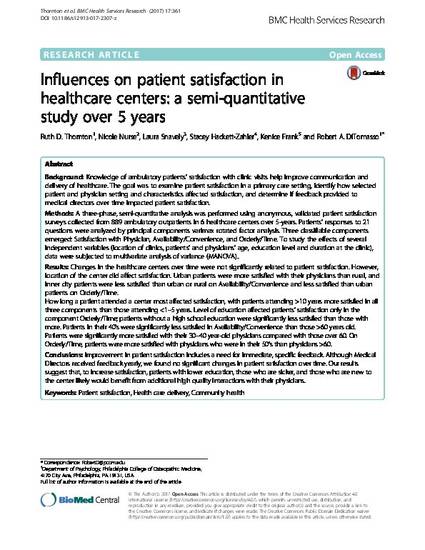
BACKGROUND: Knowledge of ambulatory patients' satisfaction with clinic visits help improve communication and delivery of healthcare. The goal was to examine patient satisfaction in a primary care setting, identify how selected patient and physician setting and characteristics affected satisfaction, and determine if feedback provided to medical directors over time impacted patient satisfaction.
METHODS: A three-phase, semi-quantitative analysis was performed using anonymous, validated patient satisfaction surveys collected from 889 ambulatory outpatients in 6 healthcare centers over 5-years. Patients' responses to 21 questions were analyzed by principal components varimax rotated factor analysis. Three classifiable components emerged: Satisfaction with Physician, Availability/Convenience, and Orderly/Time. To study the effects of several independent variables (location of clinics, patients' and physicians' age, education level and duration at the clinic), data were subjected to multivariate analysis of variance (MANOVA)..
RESULTS: Changes in the healthcare centers over time were not significantly related to patient satisfaction. However, location of the center did affect satisfaction. Urban patients were more satisfied with their physicians than rural, and inner city patients were less satisfied than urban or rural on Availability/Convenience and less satisfied than urban patients on Orderly/Time. How long a patient attended a center most affected satisfaction, with patients attending >10 years more satisfied in all three components than those attending60 years old. Patients were significantly more satisfied with their 30-40 year-old physicians compared with those over 60. On Orderly/Time, patients were more satisfied with physicians who were in their 50's than physicians >60.
CONCLUSIONS: Improvement in patient satisfaction includes a need for immediate, specific feedback. Although Medical Directors received feedback yearly, we found no significant changes in patient satisfaction over time. Our results suggest that, to increase satisfaction, patients with lower education, those who are sicker, and those who are new to the center likely would benefit from additional high quality interactions with their physicians.
Available at: http://works.bepress.com/robert_ditomasso/45/

This article was published in BMC Health Services Research, Volume 17, Issue 1, Page 361.
The published version is available at http://dx.doi.org/10.1186/s12913-017-2307-z .
Copyright © 2017. CC BY 4.0.